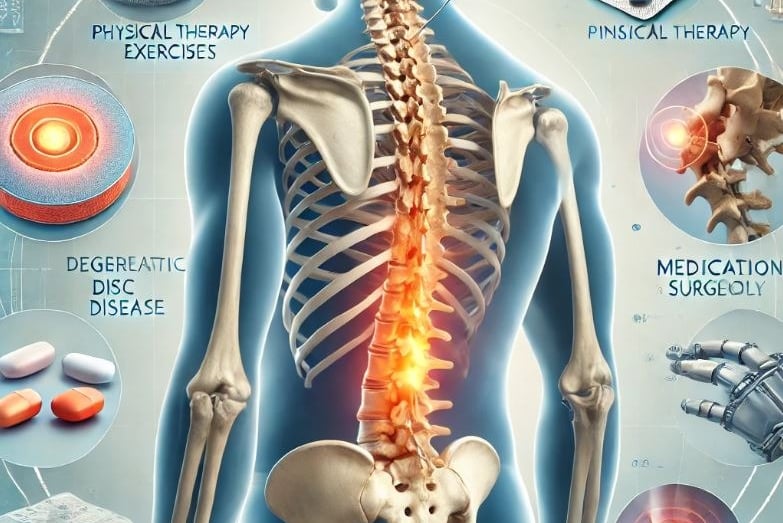Degenerative disc disease treatment: A comprehensive guide to managing spine health
Discover transformative insights and innovative strategies to manage and treat degenerative disc disease. Dive into a comprehensive exploration of its causes, symptoms, and the latest advancements, empowering you with the knowledge to navigate spinal health effectively.
LIFESCIENCES AND HEALTHCARE
2/26/20254 min read


Transformative approaches in degenerative disc disease treatment: Innovations and early intervention strategies
Degenerative disc disease (DDD) is a common condition that affects millions of people worldwide, causing chronic back pain, reduced mobility, and a significant impact on quality of life. While aging is the primary factor, lifestyle choices, genetics, and environmental factors can also contribute to the progression of this condition. The good news? Advances in medical science have revolutionized degenerative disc disease treatment, offering hope through innovative therapies like regenerative medicine, minimally invasive procedures, and personalized treatment plans. In this comprehensive guide, we’ll explore the causes, symptoms, and latest treatment options for DDD, along with practical tips for managing spine health and improving your quality of life.
What is Degenerative Disc Disease?
Degenerative disc disease refers to the gradual deterioration of the intervertebral discs, which act as shock absorbers between the vertebrae of the spine. Over time, these discs lose hydration and elasticity, leading to pain, stiffness, and reduced flexibility. While nearly every adult over 60 shows some signs of disc degeneration, not everyone experiences significant symptoms. However, for those who do, the impact can be life-altering.
Common symptoms of degenerative disc disease
The symptoms of DDD can vary depending on the severity of the condition and the location of the affected discs. Common signs include:
Lower Back Pain: Often the primary complaint, exacerbated by activities like bending, lifting, or prolonged sitting.
Radiating Pain: Pain may extend to the hips, buttocks, or legs (sciatica) if nerve roots are compressed.
Numbness and Tingling: These sensations may occur in the arms or legs due to nerve compression.
Reduced Mobility: Stiffness and limited range of motion are common, especially in the morning or after periods of inactivity.
Why early diagnosis and intervention matter?
Early diagnosis of degenerative disc disease is crucial for effective management. Identifying symptoms like persistent back pain or stiffness allows healthcare providers to recommend timely treatment plans that can slow the progression of the condition and improve quality of life. Delaying treatment, on the other hand, can lead to worsening symptoms, including chronic pain, nerve damage, and even loss of bowel or bladder control in severe cases.
Degenerative disc disease treatment options
Non-Surgical treatments
Non-surgical treatments focus on relieving pain, improving mobility, and strengthening the muscles that support the spine. These include:
Medications: Over-the-counter pain relievers like ibuprofen or prescription medications for severe pain.
Physical Therapy: Tailored exercises to improve flexibility, strength, and posture.
Lifestyle Modifications: Weight management, ergonomic adjustments, and regular low-impact exercise.
Epidural Steroid Injections: Anti-inflammatory medications injected near the spinal nerves to reduce pain and swelling.
Minimally invasive procedures
For patients who don’t respond to conservative treatments, minimally invasive options offer effective relief with shorter recovery times:
Intracept Procedure: Targets specific nerves to alleviate pain without disrupting spinal structure.
Nerve Blocks: Temporarily block pain signals from affected nerves.
Injectable Gels: Experimental treatments that aim to restore disc hydration and function.
Surgical treatments
Surgery is considered when non-surgical and minimally invasive options fail to provide relief. Common procedures include:
Spinal Fusion: Fuses two or more vertebrae to eliminate motion and reduce pain.
Artificial Disc Replacement: Replaces a damaged disc with an artificial one, preserving spinal flexibility.
Discectomy: Removes part or all of a herniated disc to relieve nerve compression.
Emerging innovations in degenerative disc disease treatment
The future of DDD treatment lies in regenerative medicine and technology-driven solutions. Here are some exciting advancements:
Stem Cell Therapy: Uses mesenchymal stem cells (MSCs) to regenerate damaged disc tissue and reduce inflammation.
Platelet-Rich Plasma (PRP): Injects growth factors to promote healing and improve disc health.
AI-Driven Diagnostics: Artificial intelligence analyzes imaging data to provide accurate diagnoses and personalized treatment plans.
3D-Printed Scaffolds: Biomaterials designed to support tissue regeneration and restore disc height.
Lifestyle modifications for better spine health
Managing degenerative disc disease isn’t just about medical treatments—it’s also about making lifestyle changes to support your spine. Here are some tips:
Maintain a Healthy Weight: Excess weight puts additional strain on your spine.
Practice Good Posture: Avoid slouching and use ergonomic furniture.
Stay Active: Engage in low-impact exercises like swimming, yoga, or walking.
Quit Smoking: Smoking reduces blood flow to spinal discs, accelerating degeneration.
Overcoming barriers to advanced treatments
Access to advanced treatments for DDD can be limited by factors like cost, geographic location, and lack of awareness. Here’s how to address these challenges:
Explore Insurance Options: Check if your insurance covers minimally invasive or regenerative therapies.
Seek Second Opinions: Consult multiple specialists to explore all available treatment options.
Educate Yourself: Stay informed about the latest advancements in DDD treatment.
The future of degenerative disc disease treatment
The field of DDD treatment is rapidly evolving, with a focus on personalized medicine and non-invasive options. Advances in genomics, AI, and regenerative therapies are paving the way for more effective, tailored treatments that address the root causes of disc degeneration. As research continues, patients can look forward to even more innovative solutions that improve outcomes and quality of life.
Take control of your spine health today
If you’re experiencing back pain or have been diagnosed with degenerative disc disease, don’t wait to seek help. Early intervention can make a significant difference in managing your symptoms and improving your quality of life. Consult a spine specialist today to explore your treatment options and take the first step toward a pain-free future.
